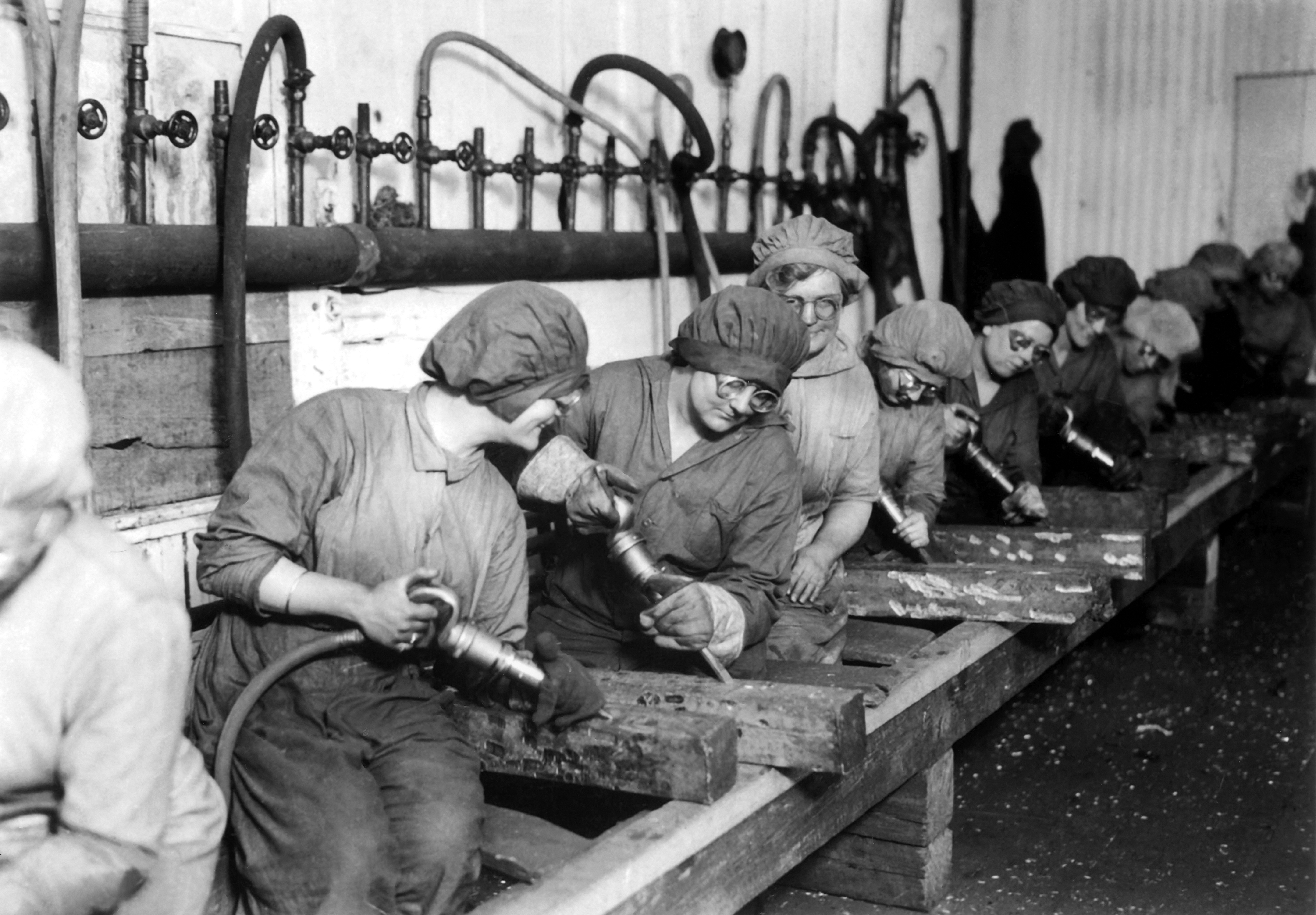With the country at war and the Democratic Party narrowly controlling both House and Senate, Americans seemed to be crowding polls for the November 5, 1918, congressional election. “Voters began as soon as the polls opened at 6 o’clock this morning,” the afternoon South Bend News-Times reported in Indiana. “and there has been a steady stream up to 2 o’clock this afternoon.” “Heavy early voting was reported,” the Wilmington, Delaware, Evening Journal told readers. An Associated Press bulletin noted an “early rush for the polls” throughout New York State. In Connecticut, heavy turnout by 9 a.m. in Bridgeport “showed the interest was keen,” the Bridgeport Times noted.
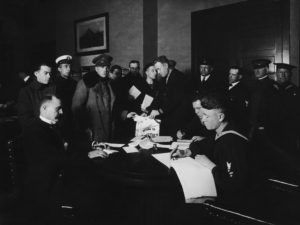
The voters knew well that they had just lived through an election campaign unlike any in American history—conducted amid a vicious war and a flu pandemic, with parties spending unprecedented amounts beseeching them for their votes, the norms of presidential propriety tossed aside, and, in New York, a million women enfranchised for the first time. What voters in 1918 could not have known was that they were delivering one of America’s most consequential midterm elections, a watershed event that thoroughly reshaped American politics and foreign policy.
“With the country enjoying unparalleled prosperity and the great crusade for democracy drawing to a triumphant conclusion, the chances seemed remote that President Wilson would be repudiated at the polls,” historian Seward W. Livermore wrote later. Voters did repudiate Wilson; for the first time in a decade, the GOP took control of both houses of Congress—the Senate by two seats, the House by 41. Republicans used that power to reduce the nation’s influence in international affairs. Turning their backs on Wilson’s vision of “America as the savior of the world,” the Grand Old Party refused to ratify the Treaty of Versailles ending World War I and rejected membership in the League of Nations. The 66th Congress opened the way for the Twenties to roar by sending the states two quickly approved constitutional amendments. One prohibited “intoxicating liquors,” initiating an era of speakeasies and bathtub gin; the other enfranchised women nationwide, a political liberation that soon was encouraging the rise of the flapper. “The 1918 campaign was one of the most hotly contested on record,” Livermore said. That election story interweaves many narratives which coalesced on November 5. Political campaigns—politics itself—had turned into a different kind of game.
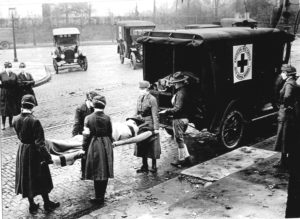
The first strand began in March 1918, when a soldier at Fort Riley, Kansas, came down with a strange kind of influenza that proved shockingly contagious. Within a week 521 other men were in the camp hospital with the same sore throat, chills, fever, and worrisome lung damage. Authorities reported huge numbers of cases. Most patients recovered quickly, and the virus seemed to die out in the States that summer while raging through much of the rest of the world. But in fall 1918, the flu reemerged domestically in a more dangerous form and in pandemic proportions. During October alone, flu killed 195,000 Americans. Because they were likely to be living in crowded conditions, those dying in their 20s and 30s far outnumbered the elderly killed by the flu. The disease particularly ravaged soldiers crowded into barracks and stuffed into troopships bound for Europe. On October 15, Representative Jacob Meeker (R-Missouri) died of the flu.
The pandemic contorted campaign planning. The Louisville, Kentucky, Courier-Journal reported on October 7 that both major parties might “cancel every speaking date during the entire time between now and the November election.” With state after state banning public gatherings, the parties suspended extensive rally schedules. Some locales still allowed outdoor religious gatherings, offering a dodge candidates in Kansas tried to exploit until authorities closed the loophole. Nebraska lifted its ban on rallies only on November 1. Some campaigns tried to use the flu as a campaign tool. Eight state ballots included proposals to restrict sale of alcoholic beverages, although the liquor industry argued in an Ohio newspaper ad that “liquor has saved many a life recently in this terrible epidemic of influenza.”
Instead of returning home to stump, many candidates, including Senator Charles L. McNary (R-Oregon) and Senator William E. Borah (R-Idaho), stayed put in Washington, DC. Electioneering, once conducted face to face, now depended on print. “The campaign has been most unusual this year in that it has been one carried on principally through literature,” the Salt Lake City Deseret Evening News wrote November 2. The parties leaned harder on public relations, trying for more—and more favorable—coverage. They spent more on newspaper advertising. And they mailed many more broadsides and pamphlets to voters’ homes. According to J. Alexander Navarro of the University of Michigan, “Direct mailing had been used before, but this gets really ramped up as a result of candidates not being able to meet directly with voters.” The parties got loyal volunteers to write letters supporting their candidates, and to make telephone calls to friends and neighbors—methods that proved so successful they joined campaign arsenals for good two years later, abetted by Republican millions spent on advertising, most of it in national magazines, Warren Harding spent his successful 1922 presidential run mainly on his front porch (“Porch Politics,” August 2015) in Marion, Ohio.
The flu reshaped election-day mechanics. With few states offering any means of casting ballots but in-person voting, election officials clamped down. Voters waiting for a booth had to do so in the open air; inside, election workers and fellow voters forbade smoking. Restrictions were most severe in the far West, where the pandemic was waxing. In Sacramento, California, some polling places did not open for lack of healthy workers. Spokane, Washington, placed booths outside in the sunshine; Salt Lake City set booths in tents. In Idaho, voters in line could not stand side-by-side but had to queue single file. San Franciscans caught not wearing masks outside faced a fine of $5—today, about $100.
Despite high interest in the election and the zest to vote, restrictions kept turnout about 10 percentage points below 1910 and 1914 levels. In the dozen states where women had the vote, female participation faltered because so many women felt compelled to stay home nursing the sick. The early surge in voting was revealed chiefly to have reflected desire to avoid historically crowded afternoons at the polls. “The low turnout did not appear to raise concerns about the legitimacy of the 1918 election results,” Jason Marisam of Hamlin University School of Law wrote. “The public appeared to accept the results generally.”
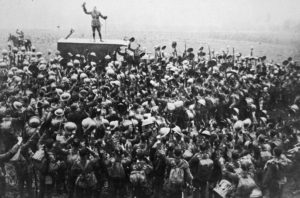
The overarching element in 1918, of course, was the war. On May 27 Woodrow Wilson, well into his second term as President, asked Congress to forgo reelection campaigning and stay in session in Washington because during wartime “politics is adjourned.” Campaigning was put on hold again in early October during a government drive to get Americans to buy liberty bonds to finance fighting. By late October, peace loomed; talks with the Central Powers had reached so crucial a point that the State Department asked Wilson not to travel home to New Jersey to vote in case he was needed in Washington. On November 3, Austria accepted Allied terms to end fighting; hoping to sell voters on supporting the Wilson administration, Democrats distributed copies of the Austrian surrender at the polls.
But fighting in Europe through summer and early fall had been fierce. Both parties tried to use the conflict to prod voters. Republicans insisted they would be tougher than the incumbent administration in extracting peace terms. “Republican success will not only insure vigorous prosecution of the war, but will be a guarantee against a compromise and, therefore, an inconclusive peace,” Representative Simon D. Fess (R-Ohio), the party’s campaign chairman, said at a kickoff event. The GOP claimed to be the better party to handle life after wartime. Henry Cabot Lodge of Massachusetts, leader of the Senate’s Republican minority, argued that “when the time for reconstruction comes, the Republican party—which has always been the constructive party—is best adapted for the work.”
As could be expected, the Democrats took the opposite tack, calling continuity in leadership and support for Wilson essential to military victory. Homer S. Cummings, vice chairman of the Democratic National Committee, kicked off that party’s campaign. “Our President has become the leading figure in affairs of the world,” Cummings said. “There is only one issue: shall we help or hinder the President?” By tradition the White House, at least publicly, stayed out of congressional elections, but Wilson himself joined the fray, urging fellow New Jerseyites to pick Democrats for the two Senate seats open that year.
On October 25, Wilson went further. In a letter beginning “My Fellow Countrymen,” he pleaded, “if you have approved of my leadership and wish me to continue to be your unembarrassed spokesman in affairs at home and abroad, I earnestly beg that you will express yourself unmistakably to that effect by returning a Democratic majority to both the Senate and the House of Representatives. . .The difficulties and delicacies of our present task are of a sort that makes it imperatively necessary that the nation should give its undivided support to the Government under a unified leadership, and that a Republican Congress would divide the leadership.” To put muscle behind his plea Wilson warned that electing a Republican majority in either Capitol chamber “would be certainly interpreted on the other side of the water as a repudiation of my leadership” and that America’s allies “would find it very difficult to believe that the voters of the United States had chosen to support their President by electing to the Congress a majority controlled by those who are not in fact in sympathy with the attitude and action of the Administration.”
Wilson had gone too far. Direct election of Senators and primary elections for House candidates were both relatively new phenomena. Until 1912 individual voters had had a much smaller role in choosing members of Congress. Now, in federal and state by state changes they were electing solons directly, making Wilson’s direct appeal to voters unprecedented—and particularly egregious, given his May demand that campaigning stand down to boost the war effort.
The outcry was immediate. “The gloves are off,” a Republican senator declared to the Washington Post. “From now on we fight with bare knuckles.” In February 1918, the Republican Old Guard had pushed aside the party’s progressive wing and installed Indiana politico Will H. Hays as chairman of the party’s national committee. Hays derided Wilson’s suggestions that Republican legislators were somehow less supportive of the war effort than Democrats and that Republican victories would make it harder for the country to achieve victory. Hays likened those assertions to “an autocrat calling himself a servant but bidding for the mastery of this great, free people…A more ungracious, more unjust, more wanton, more mendacious accusation was never made by the most reckless stump orator, much less by the President of the United States.”
“This is not the President’s personal war. This is not the war of Congress,” Republican congressional leaders fumed collectively. “It is not the war of the Democratic party. It is the war of the American people.” On election eve, the most recent Republican presidents—Theodore Roosevelt and William Howard Taft—jointly declared that the only way to throttle Wilson’s audacity was for “all Americans who are Americans first to vote for a Republican Congress.” They did. The GOP picked up 24 House seats and ousted Democrats from Senate seats in New Hampshire, Delaware, Wisconsin, Illinois, Missouri, Kansas and Colorado, losing only a seat in Massachusetts. Wilson’s October 25 letter, most analysts agree, was directly responsible for the Democratic losses 11 days later.
As the Lamar Register in Colorado editorialized November 6, the outcome “turned in all probability more completely on one issue than ever before. The president’s letter practically demanding that the voters give him a Democratic Congress to complete his war policy was made the issue immediately…. The response of the people is ample evidence that they do not desire to combat a dictator in Germany by making one in America.”

Among Democratic defeats, perhaps the most startling came in Michigan. Wilson personally had persuaded automobile mogul Henry Ford, 55, to stand as the Democratic candidate for that state’s open Senate seat. Ford thought so well of himself that he expected to collect the Republican senate nomination too. When another tycoon stepped into the GOP primary and won the party’s nod, the subsequent race elevated an issue roiling beneath the surface of American politics—the role being played increasingly by big money, the third strand that made the 1918 election one for the history books.
In 1910 worries about mammon in politics had led Congress to pass the Federal Corrupt Practices Act and a year later to reinforce that law. The statute set limits on how much of their own money House and Senate candidates could spend on their campaigns and required multi-state political party campaign committees to disclose their expenditures. These requirements produced data Democratic National Committee Vice-Chair Cummings cited to support a complaint as the 1918 campaigns were nearing conclusion that “lavish use of money appears to constitute the 11th hour program of the Republican leaders.” Cummings pointed to a $100,000 payment the Republican party apparatus advanced to sitting New York Senator William M. Calder to aid GOP candidates in that state. In September 1918 the Justice Department opened an investigation into illegal campaign spending in New York, Illinois, Ohio, West Virginia, and Michigan.
Lawyers at the Justice Department brought no charges regarding the other states, but the Michigan race became a major focus of concern about how money could sway elections. The cash factor saturated the August 1918 Michigan Republican primary, which Ford lost to the formidable Truman Handy Newberry, son of a former Michigan congressman and a wealthy heiress. With Ford running for senate on the Democratic ticket, the two competed again in November.
As one of the organizers of the Packard Motor Car Co., Newberry already was something of a rival of Ford, who was dreadfully shy and deeply leery of public appearances. Newberry, who served briefly as secretary of the navy under Theodore Roosevelt, was an active-duty lieutenant commander heading the 3rd Naval District, headquartered in New York City. Neither he nor Ford campaigned in person. But in newspaper advertisements and pamphlets, Newberry harped on Ford’s virulent anti-Semitism and his maneuvering to keep son Edsel out of uniform, whereas Newberry’s twin sons had enlisted in the Navy. The information tarred Ford enough for Newberry to win, though at no small cost. Data showed that by October 5 the Republican already had spent $176,568.08, mostly on newspaper ads. Hobbled by the federal law limiting him to laying out no more than $10,000 of his fortune, Newberry had use of a $99,900 campaign donation from his brother.
Ford, angry at losing the Republican primary, was absolutely furious when Newberry beat him again in November. The car maker hired a team of 40 private detectives to scrutinize both Newberry campaigns. Armed with a two-inch-thick report pinpointing what his shamuses called campaign law violations, Ford petitioned Congress to deny Newberry his seat. On December 3, the Senate opened a formal inquiry. However, by then the Justice Department had indicted Newberry for excessive electioneering spending in the primary. Convicted in March 1920, he remained in office while he appealed his conviction to the U.S. Supreme Court. In May 1921, the High Court, voting 5-4, held unconstitutional the provision of the campaign spending law under which Newberry had been convicted, saying Congress lacked standing to regulate state primary elections. Four months later, the Senate committee investigating the Michigan elections found Newberry’s primary win valid, with no credible evidence of overspending. But panel members disapproved of the shoals of money spent on the campaigns. Feeling vindicated, Newberry resigned.
According to the U.S. Senate website, “the case of Truman Newberry focused national attention on the peculiar power of the monied candidate.” In response, Congress in 1925 toughened the Federal Corrupt Practices Act by broadening the law to more political entities and requiring more reporting of donations. But, the Senate history admits, “despite these endeavors, financial irregularities in Congressional campaigns continued to occur during the next several decades.”
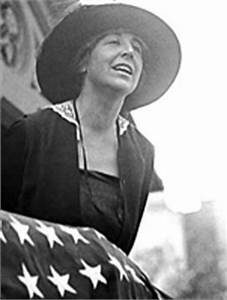
A fourth factor shaped 1918 election outcomes: women. Exit polls and other means of analyzing how subsets of voters cast ballots did not yet exist, obscuring how the women’s vote affected races in the 12 states where they held the franchise. However, votes by newly enfranchised women in New York State likely elected Grace Norris as coroner of Oneida County—the first woman in the country to hold such a position anywhere. Both women running in Senate races lost to incumbents. In Nevada Anne Martin, running as an independent, lost to Democrat Charles Henderson. Jeannette Rankin of Montana, who had already served one term as the first woman in the House of Representatives, ran on the National Party ticket and was defeated by Democrat Thomas J. Walsh.
But women showed their clout in 1918 in two ways. Strong campaigning persuaded male voters in Oklahoma, South Dakota, and Michigan to adopt, by comfortable margins, ballot measures giving women the vote in those states. Suffragists’ campaigns emphasized women’s outsize role in the war effort—serving as nurses and working as farm hands and at other jobs vacated by men now in uniform—and argued that getting the vote was an appropriate reward. Moreover, women’s fierce opposition to sitting senators who had obstructed a woman’s suffrage amendment to the Constitution led to the surprise defeat of Democrat Willard Saulsbury Jr. of Delaware and Massachusetts Republican John W. Weeks, ejected from the only Senate seat the Democrats gained in 1918. “The election has taught beyond dispute that opposition to suffrage is not politically safe for either party,” a Tennessee newspaper editorialized.
Women’s political muscle, innovations in politicking inspired by pandemic restrictions, the war, and Wilson’s tone-deaf vote-mongering, amplified by massive campaign spending, exerted transformational impact. The majority turned its back on the bipartisan progressivism that had characterized the Roosevelt, Taft, and Wilson administrations. In definitively rejecting Wilson’s internationalism and the progressivism that had come to dominate American politics since the start of the 20th century, voters in effect were winding the clock back to the late 1890s and the murdered William McKinley’s soporific nationalism and doing so under the influence of profound changes in campaigning and electioneering. “The 1918 congressional election was the first step toward the return to normalcy that characterized the United States during the 1920s,” historian Howard A. DeWitt, professor emeritus at California’s Ohlone College, has written. “The election repudiated Wilson’s progressivism and the nation returned to the ideals of William McKinley.”
This is a web-exclusive story by American History. For more stories in print, subscribe to our magazine.

